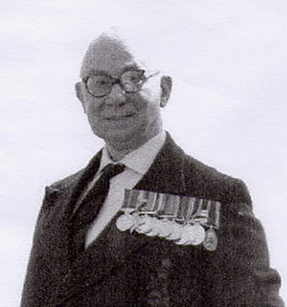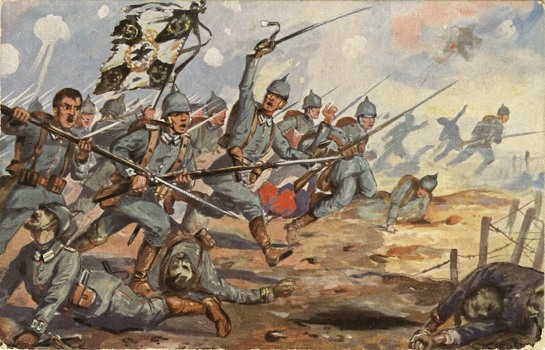The concluding pages of Book 2 deal chiefly with the advance stages of the British Army’s great push on 1st July 1916. Now I want to speak of the later stages or, in other words, things worth describing other than the actual fight.
First of all I want to say a few words regarding our opponents on July 1st. It is the general impression of our English folk at home that our enemy is “pas bon”. Well, to an extent, they are right, but we must not forget that there is the good and bad of all things. Since being out here our Regiment, the Queen Victoria’s Rifles, have been up against many types of our enemy. Those that are savages include the Silicians, Bavarians and Hohenzollerns. Of the decent fighters we have the Saxons and the most famous Prussian Guards. It is of the latter that I wish to speak now for we were up against them on July 1st during our attack on Gommecourt. As is generally understood, we found these Prussian Guards to be splendid specimens of manhood, their average age could be put at about 29 years, they stood 6 foot high quite easily and were well built with it. I must say we were all surprised at the way in which these men behaved. As I have said before, we took a large number of them prisoner. These, of course, get over ‘No Man's Land’ the best way possible and are rounded up in our communication trenches. It was in our trenches where I saw them do many good deeds. One Prussian came in with a gash in his arm about eight inches long. He had not gone far before he spotted one of our men on the ground wounded in the leg. He immediately forgot his own troubles and, taking his own bandages out of his pocket, he proceeded to attend to our man’s wants and then carried him to our “dressing station”. Many others were seen to be doing the same kindness to our wounded.
Now I will describe to the best of my ability what I saw on 2ND JULY 1916 when we had a so-called “Armistice”; at least as far as rifle fire was concerned. When we got the order to go over the top, it was somewhere about 2.30pm, our good old Doctor, Captain Dark, led the way. I was hard on his heels. Making use of the scaling ladders and other utensils previously used for the attack, we quickly passed over our own troops heads until we found ourselves in ‘No Man’s Land’ - this sight I shall never forget. We had, for our own benefit of course, removed all our barbed wire entanglements to enable our men to move quickly and easily. The front of our trenches were smashed about a good bit by the enemies’ shell fire and in some places the parapets were completely blown in.
Now directly I jumped over our own parapet I was in what we military term ‘No Man’s Land’ for the simple reason that neither side owns it. The land varies in size; for instance at Messines it was 1,000 yards across but at Gommecourt it was 500 yards and the distance across ‘No Man’s Land’ in one trench I was in was as little as 25 yards.
Now, once in ‘No Man’s Land’ I got a view of a modern time battlefield and, my God!, what a sight! The first thing one looks for after an attack is the number of dead and, seeing that I act as a Stretcher Bearer, it is part of my duties to ascertain that “dead men” are dead or else they may lie in front of our trenches and die of exposure. Another thing one notices when viewing a battle-field, especially one like Gommecourt, is the vast amount of shell holes. I guarantee to say you could not walk half a dozen paces without falling into a shell hole.
Now, from where I first jumped over our trenches, I could see both the German dead and our own in all sorts of awful positions. The wounded had crawled into shell holes and waited till we could reach them. Leaving our own trenches we started getting the wounded back. I, with the Doctor, was searching for our beloved officer, Captain Leys Cox. Working my way over ‘No Man’s Land’ without success, I determined to go through the German wire entanglements and look for him there but, alas, I was stopped by a German doctor wearing an ‘Iron Cross’ who promptly demanded my business. Upon being told, he informed me that, if I ventured past their entanglements, I should be shot. So, of course, I took the hint and shifted.
Now a word about the Germans’ trenches. These, I must say, suffered heavily at the hands of our gunners but the interior of the trenches were very strongly constructed. They had dug-outs something like 40 and 50 feet under ground and these were fitted with tables, seats and electric light. Of course, a fair amount of men took refuge in these dug-outs during the scrap and, being unable to see what was going on up above, it was quite easy for us to take them prisoner when we reached their trenches.
The signal for the end of the “Armistice” was the blowing of whistles and one shot being fired. When this went I was about half-way across ‘No Man’s Land’ so I proceeded to make for the nearest point of our trenches but, alas, not before a sniper had spotted me. His first shot just passed close handy on the right of me so I quickly changed my position and just as I mounted our own trenches he let fly again but, being a very poor marksman, he put on too much elevation and missed me again.
Once back in my own front line I had to take charge of a stretcher case. This man had been lying in a shell-hole all night and we found him at 2.30 p.m. on the 2nd July. One man we brought in had two wounds. He got slightly wounded when he first went over; he came back, had his wound dressed and then went out again. We found him with a badly smashed leg. One case I had was a Sergeant in the Royal Fusiliers. He had three ribs broken. I started from the dressing-station at 11pm and arrived back with the Sergeant at 4am, so you can guess we had our work cut out to get him back. I don’t think I need say anything more on the “Armistice” as no doubt my description will give you a good idea.
Now when you are in a village which is being heavily shelled and it is time for you to leave because your relief has arrived, you naturally wish the Germans further. Well, I must say we were lucky to get out of it all right because, just as we reached the end of the village, they started again, quite close to us, so we had to run for it. However, I am pleased to say we arrived at Bayencourt quite safely; but we had not been there five minutes before they started shelling that place, killing 1 L.R.B. and wounding others and these men, mark you, had just come back from the Germans’ trenches. They had jolly bad luck.
We stayed here for one night only moving the next day to St Amand. Here we stayed for 4 days during which time we were re-enforced. We then proceeded to trenches at Beauvilliers where we stayed for 8 days. From there we went in reserve at Foncquevilliers for 8 days and then back again to Beauvilliers for another 8 days. After this 24 days in the trenches we proceeded back to St Amand where we stayed for 8 days after which we once more proceeded to Beauvilliers. After a few days up there we got the order to shift.
The buglers met the battalion at Gaudiempre at 9.30pm and we started on a 10 mile night march to Beaudricourt.
Here we stayed for three days moving off on the morning of 22ND (AUGUST) 1916 on another 12 mile journey to Villers Hospital where we stayed for one night. From here we started off on another 15 mile march to Agenville where we arrived ever so tired on the afternoon of the 23rd. Whilst here we went strictly into training, practising for our next attack.
… to be continued.






